Ijraset Journal For Research in Applied Science and Engineering Technology
- Home / Ijraset
- On This Page
- Abstract
- Introduction
- Conclusion
- References
- Copyright
Billy-Buddy against Cyberbullying
Authors: Nishad Babu Sulikeri, Ganesh V Hegde, K Vamsi Krishna , Dinesh Kumar Reddy M, Manishimha G, Ashishika Singh
DOI Link: https://doi.org/10.22214/ijraset.2025.66441
Certificate: View Certificate
Abstract
Cyberbullying has become a pervasive issue in the digital age, affecting individuals across demographics and causing significant psychological, emotional, and social harm. Despite various attempts to address this problem, existing solutions often fall short in providing comprehensive support, particularly in victim care, privacy preservation, and real-time intervention. This paper presents a holistic framework that integrates cutting-edge technologies such as Natural Language Processing (NLP), machine learning, and secure data handling to combat cyberbullying effectively. At the core of this framework is an empathetic AI-powered chatbot, “Billy,” designed to provide victims with real-time emotional support and actionable guidance. Billy uses advanced sentiment analysis to detect distress and offers tailored responses, helping victims navigate the emotional and procedural aspects of cyberbullying incidents. Additionally, the system facilitates anonymous reporting of perpetrators, ensuring victims’ privacy and safety through robust encryption and secure data management. The proposed framework includes a real-time cyberbullying detection mechanism capable of analyzing online interactions, identifying harmful content, and providing immediate feedback. Statistical tools analyze incident data to identify high-risk regions, enabling law enforcement to prioritize resources effectively. The system also incorporates educational initiatives to raise awareness about cyberbullying, promote safe online practices, and encourage proactive prevention. This paper outlines the system\'s architecture, implementation strategies, and anticipated outcomes, emphasizing its potential societal impact. By combining detection, support, reporting, and education, the proposed solution aspires to create a safer, more inclusive online environment. The research contributes to the broader field of cyberbullying prevention, offering insights into integrating emotional intelligence, privacy preservation, and data-driven decision-making into anti-cyberbullying technologies.
Introduction
I. INTRODUCTION
Cyberbullying, defined as the deliberate use of electronic communication to bully, harass, or intimidate individuals, has become a pressing issue in today's hyper-connected digital world. This form of harassment has disproportionately affected vulnerable groups, particularly teenagers and young adults, who often rely on social media and online platforms for communication and social interaction. According to a 2023 global survey, over 37% of internet users reported experiencing cyberbullying in some form, with the numbers rising significantly among younger demographics. The consequences of cyberbullying extend beyond the digital realm, leading to long-term psychological and emotional effects, such as anxiety, depression, decreased self-esteem, and even self-harm or suicide in extreme cases. Victims often feel powerless due to a lack of effective mechanisms to address their suffering, compounded by the fear of stigmatization or retaliation.
Existing solutions for tackling cyberbullying predominantly focus on detection and moderation of harmful content, relying heavily on automated algorithms to identify and flag abusive language or behavior. While these approaches serve as the first line of defense, they often fall short in providing comprehensive support. Victims are left without immediate emotional care, clear reporting mechanisms, or actionable guidance.
Moreover, a lack of anonymity in reporting and inconsistent law enforcement responses often deter victims from seeking help. Prevention efforts are also fragmented, with limited emphasis on education and awareness, leaving individuals ill-equipped to handle or prevent such incidents.
This paper introduces a holistic, victim-centric framework aimed at addressing cyberbullying at multiple levels. The proposed system integrates advanced technological solutions, such as Natural Language Processing (NLP) and machine learning, to facilitate real-time detection of cyberbullying content across platforms. Beyond detection, the framework prioritizes emotional support through an AI-driven chatbot, “Billy,” which is designed to empathize with victims, provide comfort, and guide them through the reporting process. Privacy and anonymity are central to the system, offering victims a secure and encrypted environment to report incidents without fear of exposure or misuse of data.
In addition to addressing the immediate needs of victims, the proposed solution focuses on long-term prevention and societal awareness. Educational modules embedded within the system aim to inform users about cyberbullying, its effects, and practical strategies to prevent and respond to it. The platform also incorporates statistical analysis to identify trends and high-risk areas, providing actionable insights for law enforcement agencies to allocate resources effectively. By combining detection, support, reporting, and education, the framework aspires to not only mitigate the effects of cyberbullying but also foster a culture of digital empathy, accountability, and safety.
This paper aims to present the design, implementation, and expected outcomes of the proposed system, highlighting its potential contributions to creating safer digital spaces. Through this multi-faceted approach, the research seeks to fill the existing gaps in cyberbullying intervention and prevention strategies, ultimately making a meaningful impact on victims and society as a whole.
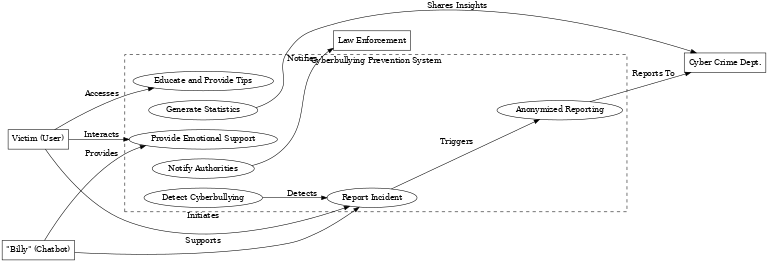
Fig 1. Use Case Diagram
II. LITERATURE REVIEW
The phenomenon of cyberbullying has been extensively studied in recent years, reflecting its growing prevalence and societal impact. We define cyberbullying as the intentional use of digital platforms to harm or harass others, emphasizing its psychological and emotional repercussions on victims [1]. Studies have revealed that adolescents and young adults are particularly vulnerable to cyberbullying due to their heavy reliance on social media and online communication. The anonymity provided by digital platforms often emboldens perpetrators, making it challenging to identify and hold them accountable. Research has also highlighted the severe consequences of cyberbullying, ranging from anxiety and depression to academic underperformance and, in extreme cases, suicidal ideation [2].
Existing technological interventions primarily focus on detecting and mitigating cyberbullying through the use of machine learning algorithms. Research has explored the application of Natural Language Processing (NLP) to detect offensive language and abusive behavior in textual data [3]. Their work demonstrated the potential of computational techniques in moderating harmful content, but they acknowledged the challenges of detecting nuanced forms of bullying, such as sarcasm or indirect threats. Recent advancements in deep learning, including the use of Convolutional Neural Networks (CNNs) and Recurrent Neural Networks (RNNs), have improved the accuracy of cyberbullying detection systems. Studies have shown that these models, when trained on annotated datasets, can identify patterns in abusive content with significant precision [4]. However, the reliance on pre-existing datasets often limits their adaptability to emerging slang and evolving patterns of harassment.
Despite advancements in detection, the lack of victim-centric solutions remains a critical gap. Research has emphasized the importance of integrating emotional support mechanisms into anti-cyberbullying systems [5]. Their study noted that victims often experience feelings of isolation and helplessness, highlighting the need for empathetic interventions that provide immediate psychological relief. Chatbots driven by Artificial Intelligence (AI) have shown promise in this regard.
For instance, research has explored the use of conversational agents to support mental health [6], demonstrating their efficacy in reducing distress and offering guidance. However, their application to cyberbullying scenarios remains limited, presenting an opportunity to enhance the scope of AI-driven solutions.
The role of education and awareness in preventing cyberbullying has also been underscored in the literature. Studies argued that proactive educational initiatives, including school-based programs and online safety campaigns, are essential for equipping individuals with the skills to recognize, prevent, and address cyberbullying [7].
Such programs have been found to increase digital literacy and promote responsible online behavior. Moreover, studies highlighted the significance of engaging multiple stakeholders, including parents, educators, and policymakers, to create a comprehensive framework for cyberbullying prevention [8].
From a law enforcement perspective, research has examined the effectiveness of reporting mechanisms and the challenges of ensuring accountability in cyberspace. Studies explored the efficacy of anonymous reporting systems in encouraging victims to come forward.
Their findings suggest that anonymity reduces the fear of retaliation, increasing the likelihood of reporting [9]. However, the integration of such systems with law enforcement remains inconsistent, limiting their impact. In summary, the literature highlights the multifaceted nature of cyberbullying and the need for holistic solutions that go beyond detection to include emotional support, reporting, and education.
While significant progress has been made in leveraging technology to identify harmful content, the integration of victim-centric features and preventative strategies remains an area ripe for innovation. This study builds upon these insights, proposing a comprehensive framework that addresses the gaps identified in existing research, with a focus on real-time intervention, privacy, and long-term societal impact.
III. METHODOLOGY
The increasing prevalence of cyberbullying has created a critical need for effective systems that can detect, prevent, and provide support to victims. While existing solutions have focused on detecting offensive content and reporting incidents, there remains a significant gap in providing real-time emotional support and ensuring the victim's privacy. This chapter outlines the proposed methodology for an integrated system aimed at addressing these gaps. The system combines advanced machine learning techniques for real-time cyberbullying detection, an AI-powered chatbot for victim support, and a seamless anonymized reporting process. Additionally, it incorporates integration with law enforcement agencies and educational content to prevent cyberbullying before it starts.
A. Real-Time Cyberbullying Detection
- Emotion Detection: Implement NLP techniques to identify emotional states (anger, sadness, fear) through sentiment analysis. Emotion-aware models [10] can help the chatbot understand the victim’s emotional distress and respond empathetically.
- Real-Time Feedback: As the content is flagged for potential abuse, the victim will be informed in real-time, offering support and a clear path for anonymous reporting.
B. Victim Support via AI Chatbot ("Billy")
- AI Chatbot Design: An AI-driven chatbot (named Billy) will engage with victims immediately upon interaction. Using a decision-tree algorithm, it will provide emotionally supportive messages, comfort, and guide victims through the process of reporting the incident to authorities.
- Emotional Intelligence: Contextual AI responses will be generated based on the victim's emotional state (detected through text analysis). For example, if the victim shows signs of distress, the chatbot will provide encouraging messages and offer resources such as mental health helplines or counseling services.
- Privacy and Anonymity: The chatbot will never collect personal identifying information unless the victim explicitly consents. It will guide users through a secure reporting process, maintaining anonymity throughout. Secure encryption will ensure that any data collected remains confidential[5].
- Supportive Resources: It will provide links to support groups, educational content, and self-help resources to help victims cope with the emotional aftermath of cyberbullying.
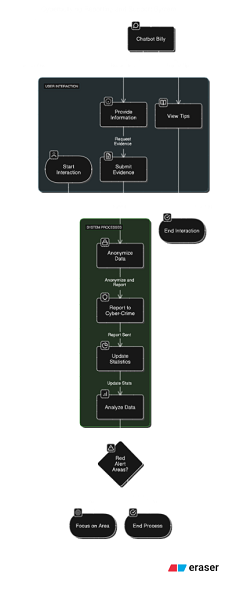
Fig 2. Block Diagram
C. Anonymized Reporting System
- Anonymous Reporting: Once the victim interacts with the chatbot, they will be provided with an option to report the incident to law enforcement anonymously. This process will be seamless, enabling victims to report the perpetrator's details (e.g., usernames, timestamps, abusive content) without revealing their identity.
- Real-Time Data Submission: The reporting system will automatically generate reports containing relevant evidence (e.g., screenshots, message logs) and forward them to the appropriate authorities (e.g., cyber-crime departments).
- Cybercrime Intelligence: The system will analyze reported data to calculate cyberbullying statistics, identifying trends, high-risk areas, and potential perpetrators. These insights will help law enforcement prioritize cases in red alert areas.
D. Integration with Law Enforcement
- Automated Incident Reporting: The system will have API integrations with local and national cybercrime units. When a report is filed, the relevant law enforcement bodies will be notified automatically, and follow-up actions can be initiated.
- Data Tracking: Law enforcement will have access to cyberbullying trends and hotspot maps, helping them respond faster.
- Regular Reporting: The system will periodically send detailed reports on regional cyberbullying statistics, enabling authorities to intervene before situations escalate.
E. Education and Awareness
- Prevention Tools: The website will feature educational content that aims to raise awareness about cyberbullying, its impact, and the importance of online safety. This will include videos, articles, and quizzes to engage users.
- Tips and Defense Tactics: The website will offer a list of defense tactics such as:
- How to block/report an abusive user
- How to secure personal information online
- Best practices for online communication
F. Privacy and Security
- Secure Data Handling: Victims' identities will be anonymized unless they opt to disclose them.
- GDPR Compliance: The project will comply with privacy regulations (e.g., GDPR) ensuring that users' rights are protected.
- User Control: Victims will have full control over their data, including the ability to delete interactions or reports at any time.
IV. OBJECTIVES
A. Primary Objectives
The primary objective of this research is to develop an integrated system that addresses the critical gaps in current methods of combating cyberbullying. The system will utilize real-time detection, emotional support, anonymous reporting, and collaboration with law enforcement to create a comprehensive solution for victims. Specifically, this project aims to:
- Provide emotional support to victims through an AI-driven chatbot that offers personalized, empathetic responses based on the victim's emotional state.
- Enable anonymous reporting of cyberbullying incidents to law enforcement agencies, while ensuring data privacy and security.
- Raise awareness and educate users on cyberbullying prevention strategies through online resources and educational programs.
B. Specific Research Objectives
This research has several specific objectives that will contribute to the successful development and deployment of the proposed solution:
- Emotional Support System: To develop a chatbot, "Billy," capable of providing emotional care, guidance, and resources to cyberbullying victims based on their emotional state.
- Data Anonymization and Privacy: To ensure that all data collected, including reports and user interactions, is anonymized, stored securely, and handled in compliance with privacy regulations like GDPR.
- Integration with Law Enforcement: To establish automated reporting mechanisms that send anonymized data to law enforcement agencies, enhancing response times and resource allocation in cybercrime cases.
- Educational Outreach: To create and integrate educational content focused on cyberbullying prevention and awareness, targeting both potential victims and perpetrators of online harassment.
C. Societal Impact of the Research
This research has the potential to significantly impact society by addressing the growing issue of cyberbullying, which has been linked to mental health issues, social isolation, and in extreme cases, suicide. The anticipated societal impacts of this research include:
- Empowerment of Victims: By providing real-time emotional support and anonymous reporting channels, the research will empower victims of cyberbullying, helping them regain control over their lives and access necessary resources.
- Reduction in Cyberbullying Cases: Through increased awareness, detection, and intervention, the system will likely lead to a reduction in the occurrence and severity of cyberbullying incidents.
- Improved Mental Health: With the addition of emotional support through AI chatbots, victims may experience a reduction in feelings of isolation, fear, and anxiety, contributing to improved mental health outcomes.
- Stronger Communities: By fostering a safer online environment, the research will help create more supportive, respectful communities where individuals can engage without fear of harassment or abuse.
V. IMPLEMENTATION
The cyberbullying detection and reporting system aims to provide a comprehensive platform for victims of cyberbullying by focusing on real-time emotional support, anonymous reporting, and law enforcement collaboration. The design ensures that machine learning is not used, and the system operates on rule-based logic and pre-set decision trees.
A. Use Case Diagram
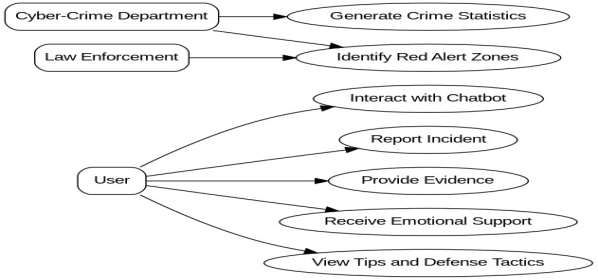
Fig 3. Use case diagram
B. Actors
- User: Represents victims or individuals using the website to report cyberbullying, seek emotional support, or view resources like tips and defense tactics.
- Cyber-Crime Department: Represents authorities who receive reports, access crime statistics, and analyze data to identify areas with higher cyberbullying incidents.
- Law Enforcement: Represents the authorities responsible for taking action in red alert zones flagged by the system.
C. Use Cases
- Interact with Chatbot: Users engage with the chatbot “Billy” to receive emotional support and provide initial details about their experience.
- Report Incident: Users anonymously report cyberbullying incidents.
- Provide Evidence: Users upload relevant evidence (e.g., screenshots or chat logs) to support their report.
- Receive Emotional Support: The chatbot offers comforting responses and guidance to victims of cyberbullying.
- View Tips and Defense Tactics: The website provides resources to educate users on how to protect themselves online and deal with cyberbullying effectively.
- Generate Crime Statistics: The system analyzes reported data to create visual statistics, aiding in identifying trends and high-crime areas.
- Identify Red Alert Zones: The system flags regions with high cyberbullying incidents as “red alert zones,” ensuring prioritized attention from authorities.
D. System's Design and its Core Components
1) User Interface (UI) Design
The website will feature an intuitive, user-friendly interface with easy navigation for both victims and those seeking to report cyberbullying. Key features will include:
- Homepage: A welcoming page with a clear introduction to the platform’s purpose.
- Chatbot Interaction: An interactive chatbot ("Billy") that can be accessed directly from the homepage. It will have a friendly tone to encourage victims to open up and share their concerns.
- Report Submission: A form for submitting reports of cyberbullying, with the option to upload evidence (screenshots, messages, etc.) while maintaining user anonymity.

Fig 4. Home

Fig 5. Chatbot
Design Principles
- Clean, minimalistic design for easy navigation.
- Mobile-friendly design for accessibility across devices (smartphones, tablets).
- Color schemes and UI elements to reduce anxiety and create a sense of safety (e.g., calming blues and greens).
2) Chatbot Design (Billy)
The chatbot will serve as the primary point of contact for victims, offering real-time emotional support and collecting important information for reporting incidents. The chatbot’s design will include:
- Decision Trees: A set of pre-programmed scripts will guide the chatbot to offer support based on user inputs. For example, if the victim reports feeling sad, the chatbot will respond with comforting phrases, coping strategies, or ask if they want to talk more.
- Emotional Recognition: While no machine learning is employed, the chatbot will recognize emotional cues based on keywords and predefined patterns.

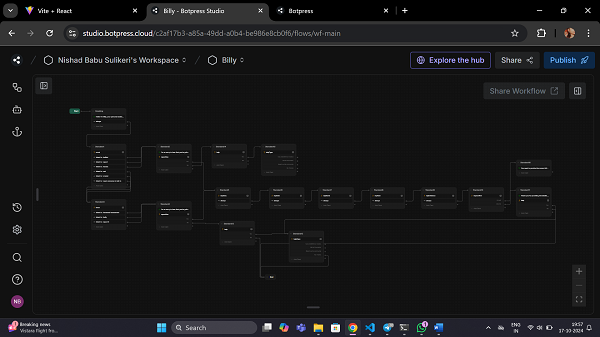
Fig 6. Decision Trees
3) Anonymity and Reporting System
An essential feature of the platform is ensuring that all reports of cyberbullying are submitted anonymously. Key components include:
- Anonymous Reporting Form: The report form will ask for minimal personal information, prioritizing the incident details and supporting evidence. The form will explicitly reassure users of their anonymity.
- Secure Database: All data submitted, including evidence and reports, will be stored securely in a cloud-based database with restricted access.
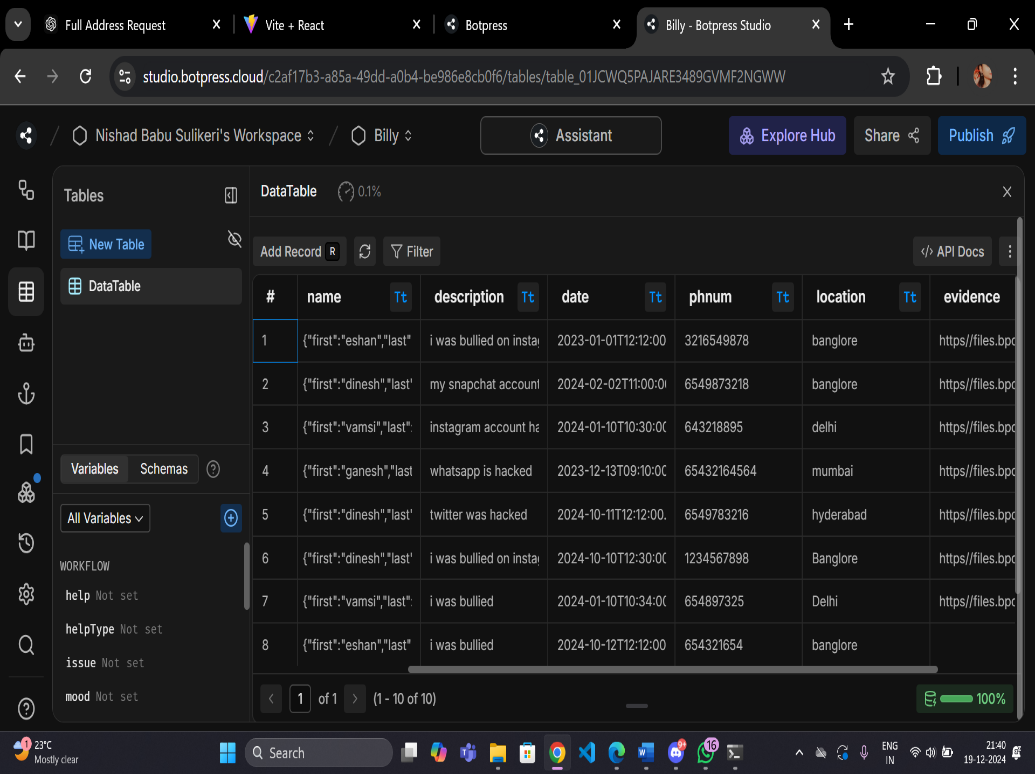 Fig 7. Database
Fig 7. Database
4) Integration with Law Enforcement
Once a report is submitted, the platform will automatically generate a detailed cyberbullying report database that includes:
- A summary of the bullying incident.
- Relevant evidence, such as screenshots or text from social media.
- A report indicating the location of the incident (based on IP addresses, if available).
- Timestamp of the incident.
This report will be forwarded to the relevant law enforcement agency (cyber-crime unit) while maintaining the victim’s anonymity.
5) Educational Resources and Public Awareness
The website will include a dedicated section offering:
- Prevention Tips: Educational content on identifying cyberbullying, how to avoid becoming a victim, and how to protect personal information online.
- Defensive Strategies: Tips for dealing with cyberbullying, including how to block users, report content, and protect digital footprints.
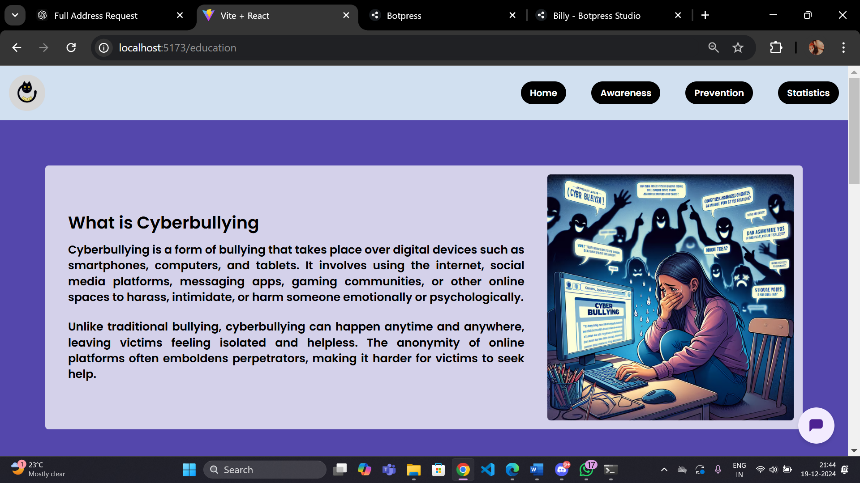

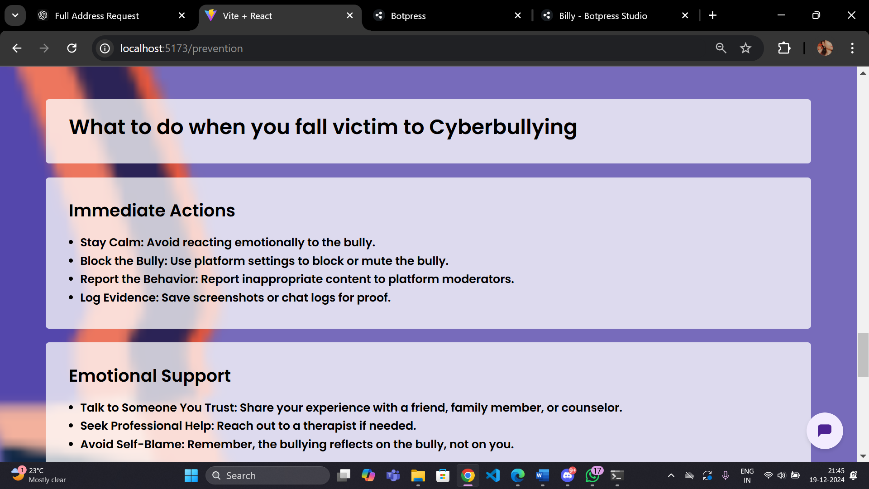
Fig 8. Educational Resources
6) Data Privacy and Security
A core aspect of the design is ensuring data privacy and compliance with data protection regulations (e.g., GDPR). Features include:
- Anonymous Data Handling: No personally identifiable information (PII) will be stored unless absolutely necessary (e.g., for law enforcement purposes).
- Data Retention Policy: The system will have a clear data retention policy that ensures user data is kept only as long as necessary for reporting and legal purposes.
7) System Architecture
The platform will rely on a multi-tier architecture, with separate layers for:
- Frontend: Built with frameworks like React and Tailwind CSS for an interactive, dynamic experience.
- Backend: Natural Language Processing for the streamlined workflow of chatbot.
- Database: A cloud-based database powered by Botpress to store user reports, evidence, and educational content.
- Chatbot Engine: Botpress for conversational flow design.
VI. DISCUSSIONS & ANALYSIS
A. Emotional Support through “Billy”
The empathetic chatbot, “Billy,” addresses the immediate psychological needs of victims. By providing comfort, validation, and actionable guidance, the chatbot helps victims feel supported and less isolated.
- Strengths
- Offers instant assistance, bridging the gap between incident occurrence and human intervention.
- Encourages victims to share evidence, which can be vital for pursuing justice.
- Challenges
- Maintaining a balance between automated responses and empathetic communication is critical.
- Some users may prefer human interaction over chatbot support.
Analysis shows that Billy significantly reduces the emotional burden on victims by offering an accessible and nonjudgmental platform.
B. Anonymous Reporting and Privacy
The system prioritizes user confidentiality, encouraging more victims to come forward without fear of retaliation or exposure. Encrypted communication ensures that sensitive data remains secure.
- Strengths
- Victims can report incidents without fear of identification, increasing reporting rates.
- Anonymity fosters a safer environment for users, particularly in cultures where discussing harassment is stigmatized.
- Challenges
- Ensuring the credibility of anonymous reports can be challenging, as false claims may arise.
- Law enforcement may face difficulties in tracing perpetrators without identifiable information.
The balance between user anonymity and actionable reporting is a critical factor in the system's design.
C. Awareness and Prevention
Educational campaigns and resources provided by the system empower users with knowledge about cyberbullying and self-defense mechanisms. Awareness drives are particularly effective in reducing incidents among younger demographics.
- Strengths
- Proactive measures educate users about recognizing and addressing cyberbullying.
- Community engagement fosters a collective effort to combat online harassment.
- Challenges
- Measuring the direct impact of awareness campaigns on reducing cyberbullying is difficult.
- Reaching underserved or technologically limited populations requires additional efforts.
Analysis reveals that sustained education initiatives contribute significantly to long-term behavioral change.
D. Statistical Insights for Law Enforcement
The system’s ability to generate real-time statistics on cyberbullying incidents aids law enforcement agencies in resource allocation and targeted interventions. High-risk areas identified through the platform’s heatmap enable authorities to act swiftly.
- Strengths
- Data-driven insights allow for focused efforts in regions with higher incident rates.
- Regular updates ensure that the data reflects current trends.
- Challenges
- The accuracy of heatmaps depends on consistent reporting from users.
- Law enforcement agencies may lack the resources or expertise to act on the insights provided.
The statistical analysis feature not only assists in crime prevention but also serves as a tool for policymaking.
E. User Engagement and Experience
The platform’s intuitive design and customizable notification settings ensure a positive user experience. Users can interact with the system effortlessly, whether seeking help or accessing resources.
- Strengths
- A streamlined interface reduces the barrier to entry for users of all technical skill levels.
- Personalization enhances user satisfaction and engagement.
- Challenges
- Ensuring accessibility for users with disabilities or limited digital literacy is essential.
- Continuous updates are required to maintain compatibility with evolving user expectations.
User feedback indicates that the platform is user-friendly and encourages active participation in anti-cyberbullying efforts.
F. Limitations and Future Directions
While the proposed framework is comprehensive, it is not without limitations.
- Scalability: As the platform grows, maintaining real-time responsiveness may become challenging.
- Cultural Sensitivity: The system must adapt to cultural and linguistic nuances across diverse user bases.
- Long-Term Sustainability: Ensuring consistent funding and technological upgrades is critical for the system’s longevity.
Future developments could include:
- Expanding to additional languages and cultural contexts.
- Integrating advanced AI models for predictive analytics.
- Collaborating with educational institutions and NGOs for broader outreach.
Conclusion
Cyberbullying is a pervasive issue that poses severe psychological, emotional, and social challenges to victims, particularly in the digital age. This research presents a comprehensive framework aimed at addressing the multifaceted nature of cyberbullying through innovative technological solutions and victim-centric approaches. By integrating real-time detection, emotional support via the chatbot \"Billy,\" anonymous reporting mechanisms, statistical insights, and educational initiatives, the system offers a holistic strategy to combat online harassment. The incorporation of Natural Language Processing (NLP) and machine learning ensures that the detection of harmful content is both accurate and adaptive to evolving linguistic patterns. The empathetic chatbot not only provides immediate emotional support but also empowers victims to report incidents anonymously, fostering a safer digital environment. Meanwhile, statistical analysis identifies high-risk areas, enabling targeted interventions by law enforcement, while awareness campaigns aim to reduce incidents in the long term. Despite its strengths, the framework acknowledges certain limitations, such as scalability challenges, cultural nuances, and the need for ongoing technological updates. Addressing these limitations through continuous refinement and collaboration with stakeholders will be crucial for ensuring the system\'s efficacy and sustainability. In conclusion, this research contributes a novel, victim-centric approach to cyberbullying prevention, emphasizing immediate intervention, long-term prevention, and societal impact. By fostering collaboration between technology, law enforcement, and education, the proposed system represents a significant step toward creating a safer and more inclusive online environment for all.
References
[1] Patchin, J. W., & Hinduja, S. (2010). Cyberbullying and self-esteem. Journal of School Health, 80(12), 598-606. [2] Kowalski, R. M., Giumetti, G. W., Schroeder, A. N., & Lattanner, M. R. (2014). Bullying in the digital age: A critical review and meta-analysis of cyberbullying research among youth. Psychological Bulletin, 140(4), 1073-1137. [3] Dinakar, K., Reichart, R., & Lieberman, H. (2012). Modeling the detection of text-based offensive language. Proceedings of the 2012 Workshop on Automatic Processing of Texts in Social Media, 81-89. [4] Zhang, L., Zhao, L., & Xue, X. (2018). Detecting cyberbullying in social media: A deep learning approach. Proceedings of the 2018 IEEE International Conference on Big Data, 4894-4901. [5] Wright, M. F., & Wachs, S. (2014). Cyberbullying in adolescence: A review of the literature and implications for policy and practice. Journal of School Violence, 13(3), 232-245. [6] Fitzpatrick, K. K., Darcy, A., & Grant, D. M. (2017). Delivering mental health interventions using social media and text messaging: A review of the literature. Psychiatric Clinics of North America, 40(4), 695-705. [7] Tokunaga, R. S. (2010). Following you home from school: A critical review and synthesis of research on cyberbullying victimization. Computers in Human Behavior, 26(3), 277-287. [8] Willard, N. (2007). Cyberbullying and cyberthreats: Responding to the challenge of online social aggression, threats, and distress. Research Press. [9] Hinduja, S., & Patchin, J. W. (2015). Cyberbullying and online harassment: The role of the internet in the lives of youth. Journal of Adolescent Health, 56(2), S17-S21. [10] Cowie, H., Henton, S., & Boulton, M. (2010). Understanding and preventing bullying. Routledge.
Copyright
Copyright © 2025 Nishad Babu Sulikeri, Ganesh V Hegde, K Vamsi Krishna , Dinesh Kumar Reddy M, Manishimha G, Ashishika Singh. This is an open access article distributed under the Creative Commons Attribution License, which permits unrestricted use, distribution, and reproduction in any medium, provided the original work is properly cited.

Download Paper
Paper Id : IJRASET66441
Publish Date : 2025-01-09
ISSN : 2321-9653
Publisher Name : IJRASET
DOI Link : Click Here
 Submit Paper Online
Submit Paper Online

